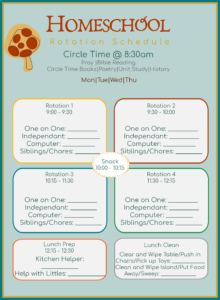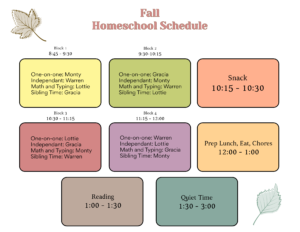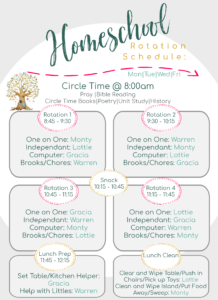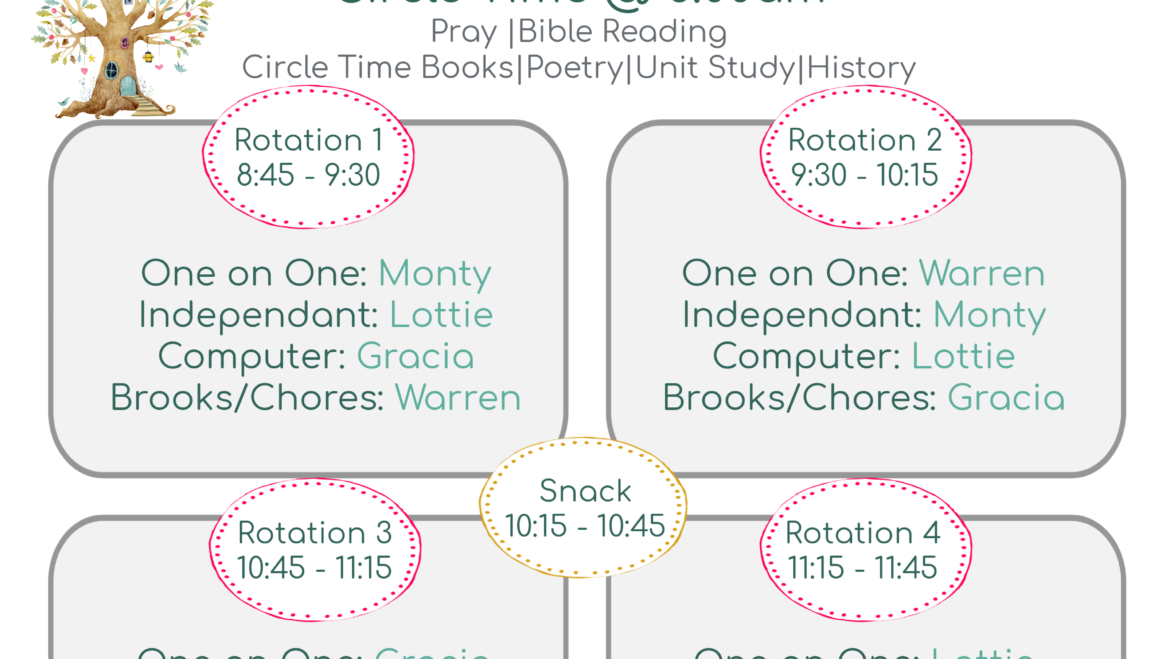We are going into our 10th year of homeschooling (crazy!) and our 3rd year of using a rotation schedule for our days. For our family, using a rotation schedule has completely changed the way our mornings flow and it has made such an incredible difference in the amount of things we are able to do in a day. In the past, we were generally led to organize our mornings based on subjects or areas of study rather than on our individual kids needs. Generally, we would all gather for circle time (which we still do with our rotation schedule), then all switch to ELA, then all move onto math, etc. etc. etc. For a while this type of routine was okay, however as my kids came out of their youngest learning years and more of their individual learning styles and abilities started coming to surface, this quickly became a very overwhelming way to operate our days. Some kids required way more assistance with writing or spelling, while others wanted to move along and quickly get through their other work. Or when we would all sit down for math time, two kids might need my attention at the same time for completely different types of problems while the others were completely finished ready to start the next subject! It was SO exhausting! Because I was constantly being pulled into so many directions, I never had the proper time I needed to help them individually. And then of course on top of that we still had toddlers or babies that were always interrupting our best laid plans. I knew something had to change.
I decided to write a list of all the positive and negative things about our current routine so that I could clearly see where and what needed to be changed, and what things we should still keep around.
Positive Things About Our Days
- I love when we can learn together or spend time outdoors together
- I love circle time in the morning
- I love when I can individually help a child catch onto a new concept (it was just very rare that it actually felt like quality individual time)
- I love having clear, laid out chores for the kids and I felt that our chore schedule was currently working well
- I love having simple lunches
- I loved the quiet time we have in the afternoon
- I loved going through unit studies with the kids throughout the day
Negative Things About Our Days
- The times when we learned together were often interrupted by a struggling child or a younger sibling
- The younger siblings never had enough one-on-one time and were constantly getting into things or causing the others to become distracted
- I never had proper one-one-one time with my kids to walk them through difficult concepts
- Things like typing were often overlooked because our days felt scattered trying to fit everything else in
- I felt like the older kids looked at their younger siblings as more of a burden than a friend because they never had enough time to just hangout
- I felt like my kids never knew what to do when they finished their work early. We never had a plan in place because it would vary so much throughout the day
After praying about our days and looking long and hard at our current routine, I decided to setup our days into rotational blocks rather than subjects. I still wanted our kids to learn some areas of study together but I wanted to ensure that they were not being held back or pushed forward based on the needs of their siblings. The way I accomplished this was by having a more focused morning time where we use that time to dive into some of the topics I wanted to go through together. However, after doing the reading and discussion part together, we would immediately separate and begin our rotations. Because I have 4 school-aged children at the moment, I separated the rotation blocks into these 4 categories:
- One-on-One with Mom
- Individual time
- Computer time (typing, online math, learning videos, etc.)
- Hanging out with younger siblings
After circle time, each of those categories last for 30-45 minutes before we rotate. We have a snack after the first 2 rotations. By the time lunch rolls around, each of my kids has had morning time, one-on-one, individual time, computer time, and special bonding time with their younger siblings. By rotating through these blocks of time I could finally keep the younger children entertained all morning. I am able to spend one-one with each child without the interruptions, and I can properly set them up with their individual time expectations, ensuring that the work I am laying out for them is clearly understood, fits their capabilities and is able to be completed in that block of time. I was also able to fit in those tricky subjects like typing. And as a bonus, if they finish their individual time early, they can use the remainder to read or play games.
For some of my kids, they need a lot more help with one-on-one time while others much prefer their individual time and have proven through the years that they learn well on their own. I try to base my time limits on those factors. If for any reason my kids do not complete their individual work because of procrastination, they know that they now need to use of their free time in the afternoon to get it done. This rarely happens because my kids love their free time when school is over.
A few questions I have had in the past about our rotation blocks:
- What do you do for your one-on-one time? That completely varies from child to child. For some of them, I will spend a lot of the time going through their math questions . (Their math is all online and self-paced so we have an extra tablet at the table for this time). For others, we spend it working on their reading or writing, or maybe going through their science or history books.
- What do you do for their computer time? Because their math is all online, this is the time that they generally do their math. When they are done math they move onto typing. If that day I helped them on their one-on-one with math and they complete it early, then they simply type and then move into learning games on the computer or an educational YouTube video. If they did not quite finish their math, they have to complete it in the afternoon.
- How to you decide what they do for their individual time? With the exception of the first child, they are all able to start with one-on-one with me before they move onto their individual time. This means that I can decide for them what to do with their individual time based on what we accomplish in their one-one-one. Generally, they will work on reading, writing, copywork, science workbooks, social studies workbooks or studies.
- What about the child who starts with individual time before they get their one-one-on? How do they know what to do if they do not have one-one-one first? I think every family has a least one child who is a self-starter and simply loves checking things off a list. Put that kids in the first individual space. Talk with them about your expectations and how you want them to use this time. In our house, that is usually our oldest. He has his books and knows how to move through them quite well without much assistance from me. Anything that he finds he needs extra help with he simply leaves alone UNTIL our one-on-one. It’s pretty much just a reversed concept from the others.
- What if you do not have enough one-on-one time and the child is still struggling? Easy! After the designated 30-45 minute time frame, close the books and move on to the next rotation and try again tomorrow. Kids do not need to be pushed to the point of hating what they are doing. Sweet and short lessons have a much stronger impact than you think and you will quickly be surprised how much you accomplish in your days when your child does not feel overwhelmed.
- Is that really enough time to get through everything? For us it usually is! It is amazing when you have a solid morning time, quality one-one-on, and awesome expectations for their individual time how well this works out. I never hesitate to add in a bit of extra work in the afternoon if needed, however that rarely needs to happen.
- What kinds of things do your older kids do with the younger kids during their sibling time? We usually make a plan in advance and I always welcome their input. Sometimes they go outside, sometimes they make forts downstairs, and sometimes they play lego. They have built simple wood projects together, made crafts, read, watched a show, gone snowmobiling, gone for walks and SO much more. And it has been such a blessing in their relationships!
- Do you do this 5 days a week? No. For our family we like to do only our circle time on Fridays and then move straight into our larger house cleaning. For a short season we had an activity on Thursday and so we had to school on Friday and post-pone the housework that day. I didn’t love that as much but it was what was needed at that time. So in general, this means that for the most part we only “school” 4 days a week. And yes we still manage to get through everything. I try to be very diligent in not scheduling friends or appointments in the morning so that this time is very focused.
If you feel like your schedule or routine needs a revamp, maybe this is something that could work well in your family, too! Definitely give it a try. And as always if you have more questions, let me know. I have attached a few schedules we have used in the past so you could see what a rotational schedule looks like for us. Never be scared to try something new. You never know what small changes could end up deeply impacting the joy, calmness, and productivity in your home!











Add Comment